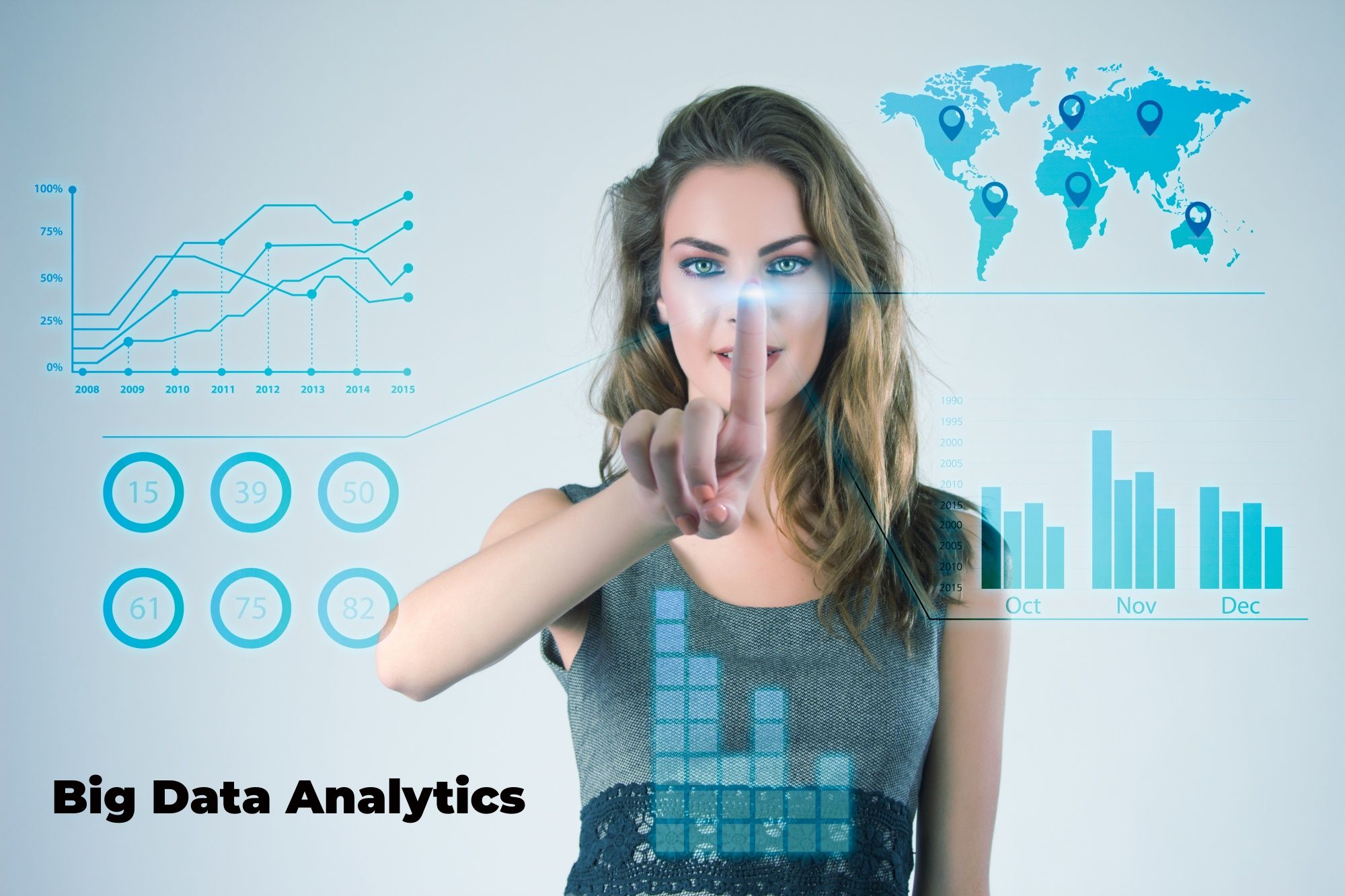Big Data Analytics
Big data analytics refers to the practice of examining large and complex datasets to detect patterns, market trends, customer preferences and any other useful insights that will allow organizations to make more informed business decisions. With digital information ever expanding exponentially in our modern era, big data analytics has become essential tool for companies across industries looking to take advantage of their own data for competitive edge.
In this comprehensive guide, we’ll look at what big data analytics is, its significance for businesses, the process and techniques associated with big data analysis as well as real world use cases as well as its outlook in terms of future possibilities.
What is Big Data Analytics?
Big data analytics refers to an approach of examining large volumes of information generated from businesses, devices, social media platforms and other sources in order to detect trends, correlations and insights that traditional business intelligence programs miss. Big Data Analysis utilizes advanced analytic techniques like data mining, machine learning and artificial intelligence as part of its process to examine all kinds of structured and unstructured data sets.
Big data analytics serves a variety of objectives. Primarily, its goal is to find hidden patterns and take-home lessons that can enhance business strategy, optimize operations, increase productivity and fuel innovation. Big data goes beyond surface level analyses by offering deeper customer and market intelligence that can impact decision making across an organization.
Key Features of Big Data:
Ongoing production of massive volumes of information; rapid rate at which new information arrives.
Volume – rapid production rate.
Velocity – Diverse sources and types of structured and unstructured information, both structured and unstructured alike.
Variety – Inconsistent or inconsistent data which does not meet requirements set out for it by standards such as ISO or NIST
Veracity – Messy, inconsistent, unreliable data.
Complexity – Difficulties associated with connecting, matching and cleaning data.
Why is Big Data Analytics Important?
Below are a few reasons that big data analytics has become such a necessity today for organizations:
Deeper Customer Insights – Analyzing customer data and behavior can reveal deeper insight into customers’ pain points, preferences and buying signals; providing more tailored marketing efforts and predictive analytics strategies.
Operational Efficiency – hrough analysis of internal sales data from sales, productions and inventory systems, companies can optimize processes while decreasing costs and increasing productivity.
Faster Innovation – Understanding industry and market trends can facilitate faster innovation by helping launch products/services to address customer needs and preferences more quickly.
Competitive Edge – Companies who utilize big data analytics gain an edge over rivals by making more strategic business moves informed by data.
New Revenue Streams – To unlock big data’s true potential and create additional streams of income for customers and markets alike, businesses need to develop products and services driven by data that meet customers’ and markets’ needs.
Big data analytics has emerged as an indispensable asset for making data-driven decisions at scale, optimizing processes, minimizing risks, seizing new opportunities and staying one step ahead of competitors.
Big Data Analytics Process
Big Data Analytics Process Gaining business insight from large amounts of data requires multiple steps:
Identify Business Objective –
The initial step to effectively using big data analytics for business is identifying your desired goals, such as improving sales, increasing customer experience and operational efficiencies or risk mitigation measures. Common goals may include these.
Data Collection –
Gather all relevant structured and unstructured information from all available sources such as CRM systems, social media pages, documents or sensors in order to collect structured and unstructured data that is both structured and unstructured in nature. A larger dataset allows more insight to be extracted;
Data Pre-processing –
This involves data cleansing to remove errors, inconsistencies and duplicate information from structured and unstructured datasets respectively. Structured information should be organized while unstructured text/image data may require processing through Natural Language Processing/Computer Vision techniques.
Data Integration –
Integrating preprocessed datasets provides a more complete picture and allows for analysis to occur quickly and efficiently.
Exploratory Analysis –
Initial exploration of cleaned, integrated data should reveal any interesting trends, correlations or questions which will provide direction for further steps in analysis and decision-making.
Advanced Analytics –
To provide valuable insight, sophisticated techniques like predictive modeling, machine learning, neural networks clustering and decision trees may be applied based on a problem statement to gain deeper insight.
Visualization –
Analytics results are communicated easily to business teams via reports, dashboards, graphs or charts for easy understanding and application of insights gained.
Implement Insights –
Once insights have been identified and action plans drawn up for them to implement across business functions such as marketing, operations and finance in order to drive growth and productivity, implementation can finally occur.
Process Improvement Requires Cross-Functional Collaboration Between IT teams managing data infrastructure and business teams setting objectives and applying insights. Overtime, ongoing iteration and monitoring ensure that both processes and results continue to evolve over time.
Big Data Analytics Techniques
A variety of advanced techniques are utilized for the analysis and interpretation of big data to yield actionable insights from it. Here are a few such key strategies:
Data Mining – Data mining refers to analyzing large data sets in order to detect trends, patterns and correlations. It uses techniques like classification, clustering and regression in order to detect any interesting points which might provide insights. Common algorithms in use today for data mining include C4.5, K-means SVM Apriori EM Pagerank.
Machine Learning – Machine learning allows computers to autonomously learn without explicit programming by recognising patterns within large datasets and building predictive models and algorithms that apply insights gained into new datasets. Popular techniques of Machine Learning are: supervised, unsupervised, reinforcement learning and deep learning.
Artificial Intelligence – Artificial intelligence systems like neural networks, Natural Language Processing (NLP), rule-based expert systems etc are used to apply advanced analytics and cognitive reasoning techniques that mimic human intelligence to big data sources.
Data Visualization – Producing engaging interactive visual displays such as dashboards, maps, graphs and charts that represent insights, trends and anomalies easily for humans to comprehend.
Prescriptive Analytics – Going beyond descriptive and predictive analyses, prescriptive analytics provides advice to optimize outcomes through action. It focuses on taking full advantage of analytic insights.
Text Analytics – With text analytics techniques such as classification, clustering and sentiment analysis being applied to emails, social media posts and documents in order to extract insights by recognizing key words/phrases/sentiment etc.
Geo-Spatial Analytics – Geo-spatial analytics is used to examine geo-tagged data and detect location-specific trends or behavioral patterns using techniques like spatial statistical models, network analysis and mapping etc.
Mastering these techniques enables organizations to maximize the benefits of big data analytics applications.
Real-World Business Applications of Big Data Analytics
Here are a few effective big data analytics applications across various industries:
Retail – Examining point of sale data, customer movements, browsing histories and inventory levels to provide tailored promotions, maximize placement options and anticipate demand.
Banking – Fraud detection by real time analysis of transaction and payment patterns to detect any irregularities and stop fraudulent activity;
Healthcare – AI analysis on patient records and medical imaging data to improve diagnostics, identify outbreak risks and develop treatment plans;
Manufacturing – Sensor data collected by machines is being analysed to optimize assembly lines, reduce downtime with predictive maintenance strategies and ensure quality control.
Government – Utilizing census, tax records and public infrastructure sensors as analytics resources in order to develop policies, streamline operations and enhance public wellbeing.
Automotive – Machine learning (ML) analytics of vehicle sensor data, GPS coordinates and dashboard cameras is being applied in this sector in order to facilitate autonomous driving capabilities, enhance safety and detect issues quickly and reliably.
Media and Sports. Both industries utilize big data analytics on viewership data, preferences and engagement with content to recommend it, target ads effectively and determine optimal pricing models. Sports uses player performance analysis data to pinpoint areas for improvement as well as optimize training regimens, talent scouting efforts and strategies.
The Applications of big data analytics are seemingly limitless; almost every industry utilizes some form of big data analysis in some capacity to enhance productivity, decision-making, and profitability by making sense of ever-increasing amounts of information.
Challenges with Big Data Analytics
There can be several hurdles associated with Big Data Analytics
Though big data analysis offers tremendous promise, successfully capitalizing upon it poses significant obstacles.
1- Capturing and storing large datasets and streams of incoming data.
2- Cleansing and standardizing unstructured, messy data coming from various sources.
3- Integrating siloed datasets while reconciling discrepancies among them.
4- Applying appropriate analytics techniques to various problem statements.
5- Utilise data science skills for designing, running and interpreting complex analytic models.
6- Ensuring regulatory compliance, privacy protection and data security despite massive data storage/processing operations.
7- Maintaining data provenance across pipelines and preventing bias from creeping into analytical models.
8- Communicating insights derived to business teams so they may utilise them effectively.
9- Measuring ROI from Big Data initiatives while continuously refining techniques.
10- Organizations need to invest in data engineering and data science talent, create an adaptable data infrastructure in the cloud and foster a data-driven culture in order to face up these challenges successfully
Future Trends in Big Data Analytics
Big data analytics will continue to become ever more widespread as more information becomes available and companies strive to become data-centric for strategic advantage. Here are a few developments we should anticipate:
Automated Insights – AI and machine learning technologies will facilitate more rapid identification of insights and patterns from data without human interference.
Real-time Analytics – Real-time analytics technologies enable organizations to analyze data continuously in real time for instantaneous decision making.
Predictive Analytics – Predictive modeling using Machine Learning and Artificial Intelligence will become mainstream for applications including demand forecasting, risk evaluation and recommendation engines.
Natural Language Processing – Unlock insights from unstructured text data using context-aware natural language processing models such as BERT and GPT-3 to unlock insights.
Edge Computing – Analytics embedded directly in edge devices such as IoT sensors, mobiles and cars can filter and process real-time data without depending on cloud transfer for processing or filtering purposes.
Advances in Visualization – Utilizing AR/VR technologies, advanced visualization techniques can now create more intuitive data visualisations with immersive insights for enhanced experience.
Democratization & Responsible AI – Making analytics tools more accessible to non-technical users while taking into account algorithmic bias and privacy concerns is at the core of democratic & responsible AI initiatives.
As technology and talent evolve, big data analytics will become all-pervasive across industries, allowing companies to utilize their data at scale and speed like never before. The future is certainly exciting for this rapidly developing field!
Conclusion
Big data analytics allows organizations to unlock game-changing business insights from vast, disparate data sets using cutting edge techniques. As such, big data has become indispensable in improving decision making, optimizing processes, mitigating risks, developing innovative products and creating sustainable competitive advantage for competitive advantage.
Realizing its benefits requires creating a reliable data infrastructure, cultivating a data-driven culture and employing advanced analytical techniques with cross-functional teams comprised of data scientists, engineers and business specialists. With big data’s exponential expansion, investment in analytics capabilities will become critical in shaping business success in today’s digital environment.




